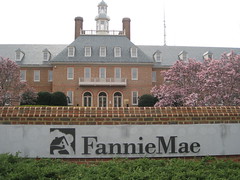NewsHour’s David Brooks and Mark Shields discuss President Obama’s speech on health care reform and what impact it will have on Congress.
NewsHour’s David Brooks and Mark Shields discuss President Obama’s speech on health care reform and what impact it will have on Congress.

Fannie Mae headquarters/Credit: Flickr/FutureAtlas
It’s been a year since both Freddie Mac and Fannie Mae were taken over by the federal government (here’s a look at why), followed by the fall of Lehman Brothers. While the recession may have deeper roots, the banking collapse got the media looking at how we got here, and now – how to get out. Planet Money’s first podcast, a year ago this week, looks at how investments in China may have contributed to banking insecurity.
Fast forwarding to this week, NPR’s Tell Me More spoke with Wall Street experts Marcus Mabry of the New York Times.
“You already had a recession, and recessions happen. That’s a normal part of life in a capitalistic system… The financial crisis took what was already a recession that was well underway and just amplified its effects,” Mabry said on the program. “I mean, the fear here – and we saw this with the recovery under George W. Bush. We saw jobless recovery for the majority of that recovery, which meant that the economy was growing, but companies were exacting so much from their current workers that they actually -as far as work and productivity – that they were actually not hiring new workers….Ironically, those banks that we talked about, the ones that survived the economic cataclysm of a year ago, are actually many of them wealthier and richer – Goldman Sachs comes to mind – than ever.”
Has the stimulus package had an effect yet on helping average Americans survive the crisis that started with the banking system? On the 200th day since the Recovery Act was passed, Vice President Joe Biden argued that the bill was an overall plan, not a single “silver bullet” for bringing back jobs and helping those in need. ProPublica’s Shovelwatch blog fact-checked some of Biden’s claims:
“According to Biden, one of the main goals of the Recovery Act was to “bring relief to those hardest hit by the recession.” But as ProPublica reported last month, a county-by-county breakdown of contracts, grants and loans showed no relationship between where the stimulus money is going and either unemployment or poverty.”
Recovery.gov has a new chart plotting tax relief so far from the Recovery Act
But while most economists agree that the worst is over, even many major banks aren’t out of the woods yet. NewsHour reported just this week that more banks may be on the road to failure, having not recovered from bad loans and the mortgage crisis.

Credit: Flickr/James Sarmiento
It’s Labor Day weekend, and Tuesday students all over the country will be heading back to school – some to the neighborhood elementary school, others to colleges far away, but a larger number than usual are starting classes at community colleges. Why the uptick?
The struggling economy has boosted community college enrollment all over the country, and in this week’s station roundup, we take a look at places where this trend is apparent.
WOSU in Columbus, Ohio first reported on this trend back in Februrary , citing both the less expensive tuition and older students who are returning to study after being laid off from their jobs as reasons enrollments have increased.
“DeVry University has grown steadily nationwide says Galen Graham, President of the Columbus Campus. In Ohio enrollment in online classes has grown by 30 percent in the past year, a change that he says could be attributed to higher gas prices and the slowing economy. Students are also staying enrolled longer.”
Salt Lake City NPR station KPCW recently found a 33% rise in community college enrollment in their area, and that the local colleges are having trouble staffing up.
“She says the college is trying to keep up with the influx of students by hiring new faculty and opening more courses. But she adds that prospective students should know their choices could be limited if they don’t act soon.”
A school counselor in California relayed her concerns about growing enrollment to Marketplace’s Tamara Keith in July:
“You know there’s nothing I hate worse than knowing there are students who have personal and family responsibilities that depend on them getting the training they need to get a job, and they come to our institutions and they can’t find the courses they need.”
At the heart of community college growth is the overwhelming expense of a four-year college education. NPR’s Tell Me More analyzed whether the pricetag reflects the benefits of education in trying economic times.
What kinds of educational choices have you had to make for yourself or your family due to the economy? Share your story here.
The arugula left has been up in arms about Whole Foods CEO John Mackey’s recent opinion piece in the Wall Street Journal stating that simply eating right would avoid the need for health care reform. The column resulted in a grassroots call to boycott the nationwide chain of health food stores.
Knowing your audience is key, Patchwork Nation director Dante Chinni notes. He looked at the effect of the grassroots campaign on the typically affluent areas where Whole Foods puts its stores.
“As CEO, Mackey must be aware of his customer’s political leanings. But a look at where Whole Foods markets are located in Patchwork Nation might have done more to convince him that sometimes discretion is the better part of healthcare opinionating.
The wealthy and educated “Monied ’Burb” communities have by far the most Whole Foods in them – 101 to be precise. That’s hardly surprising, considering the chain’s high prices (which lead some people to call the store “Whole Paycheck”).”
While areas that are more to the right have fewer Whole Foods stores, these neighborhoods have started staging ‘buycotts’ in response to the boycott.
“It may seem odd for people to buy organic produce as a way of protesting against current healthcare-reform plans. But is there a place the “buycott” might have especially long legs? Yes, the growing and diversifying “Boom Towns.”
Play audio interview: Dante Chinni talks about the Whole Foods Nation
The boycott/buycott has sparked a huge amount of press. This Los Angeles Times opinion piece by Michael Hiltzik looks at the concept of boycotts and whether they further the political discourse.
“But a wider discussion of healthcare reform, devoid of the misrepresentations and irrelevancies for which Mackey’s article has been properly criticized, is exactly what’s needed in this country,” Hiltzik writes.
Michael Pollan, food historian and author of The Omnivore’s Dilemma, responded to the debate, saying he’d still patronize the Austin-based chain:
“I haven’t examined the political views of all the retailers who feed me, but I can imagine having a lot of eating problems if I make them a litmus test.”
And an article in GOOD Magazine entitled “Boycott the Whole Foods Boycott”, notes:
“Whole Foods has built itself on image and its “pander[ing] to… customers’ political prejudges” and Mackey should have been more careful with his brand. But the boycott movement feels like a distracting sideshow in the debate over the U.S. health care system.”
By garnering attention, can a boycott and resulting ‘buycott’ create a more informed discussion issues, or is it all just noise?
I recently spoke with two Los Angeles residents who are turning their time out of work into a chance to try something new. Jamie Rubin, a former online news producer is now designing nursing shirts for new moms at Milkstars. Brian Zeno was in sales and is now managing rock bands. The story was on today’s Morning Edition on NPR.
Some of the tens-of-thousands of Americans who have lost their jobs in the recession are turning crisis into opportunity. Instead of searching for a new job in the same field, they are turning their passion into a paycheck.
Lose Your Job? Follow Your Passion